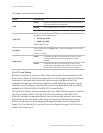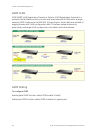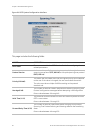Chapter 4: Web-Based Management
84 GE-DS-82 and 82-PoE Ethernet Managed Switch User Manual
• Automatically reconfigures the spanning tree to compensate for the failure,
addition, or removal of any element in the tree.
• Reconfigures the spanning tree without operator intervention.
Bridge Protocol Data Units
For STP to arrive at a stable network topology, the following information is used:
• The unique switch identifier
• The path cost to the root associated with each switch port
• The port identifier
STP communicates between switches on the network using Bridge Protocol Data
Units (BPDUs). Each BPDU contains the following information:
• The unique identifier of the switch that the transmitting switch currently believes
is the root switch.
• The path cost to the root from the transmitting port.
• The port identifier of the transmitting port.
The switch sends BPDUs to communicate and construct the spanning-tree topology.
All switches connected to the LAN on which the packet is transmitted will receive the
BPDU. BPDUs are not directly forwarded by the switch, but the receiving switch uses
the information in the frame to calculate a BPDU, and, if the topology changes,
initiates a BPDU transmission.
The communication between switches via BPDUs results in the following:
• One switch is elected as the root switch.
• The shortest distance to the root switch is calculated for each switch.
• A designated switch is selected. This is the switch closest to the root switch
through which packets will be forwarded to the root.
• A port for each switch is selected. This is the port providing the best path from the
switch to the root switch.
• Ports included in the STP are selected.
Creating a Stable STP Topology
To make the root port the fastest link. If all switches have STP enabled with default
settings, the switch with the lowest MAC address in the network will become the root
switch. By increasing the priority (lowering the priority number) of the best switch, STP
can be forced to select the best switch as the root switch.


















